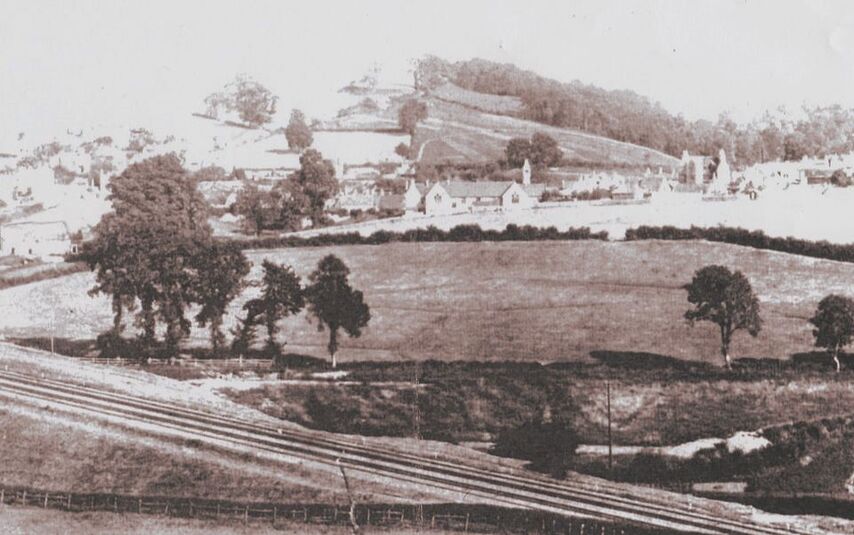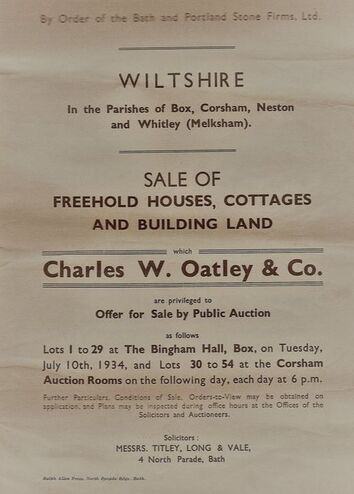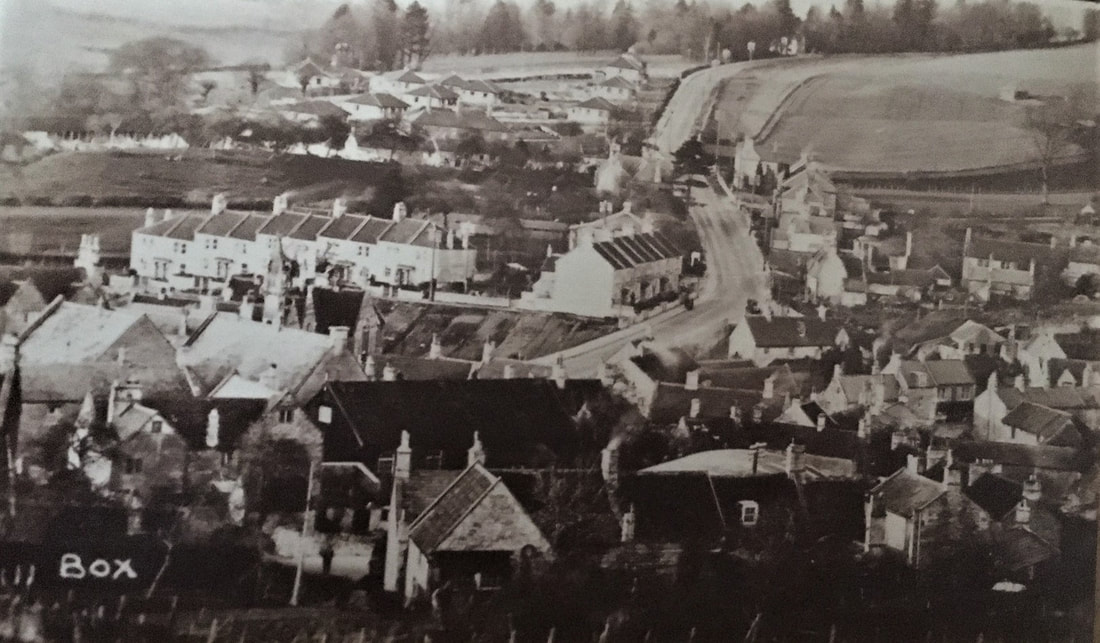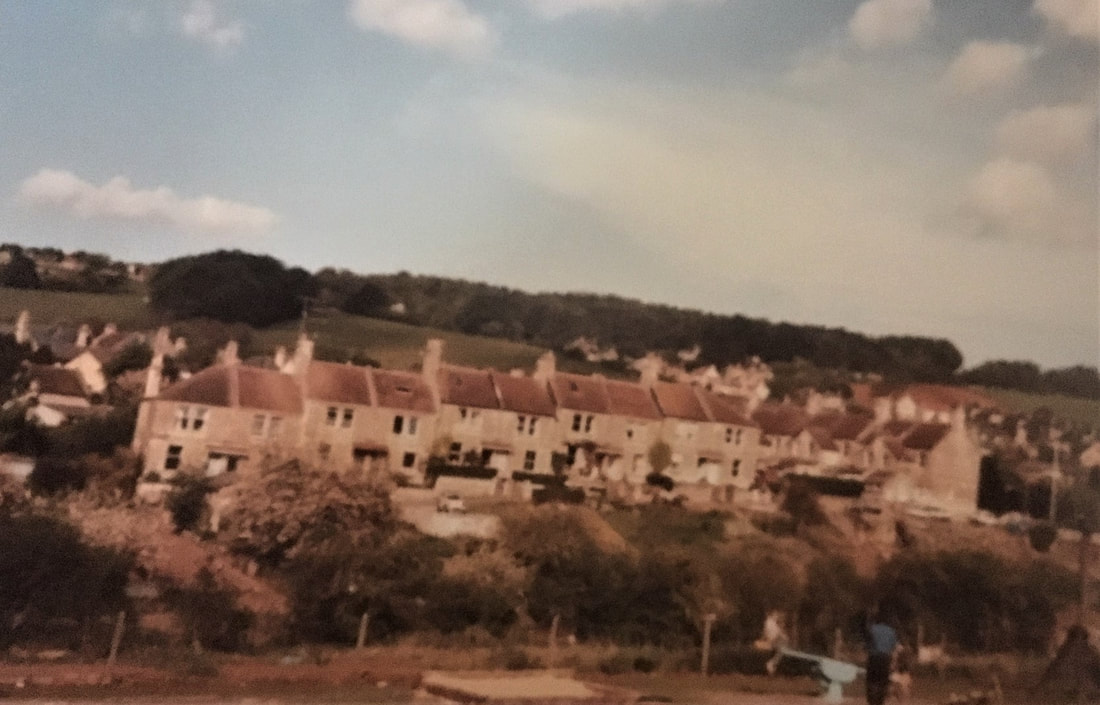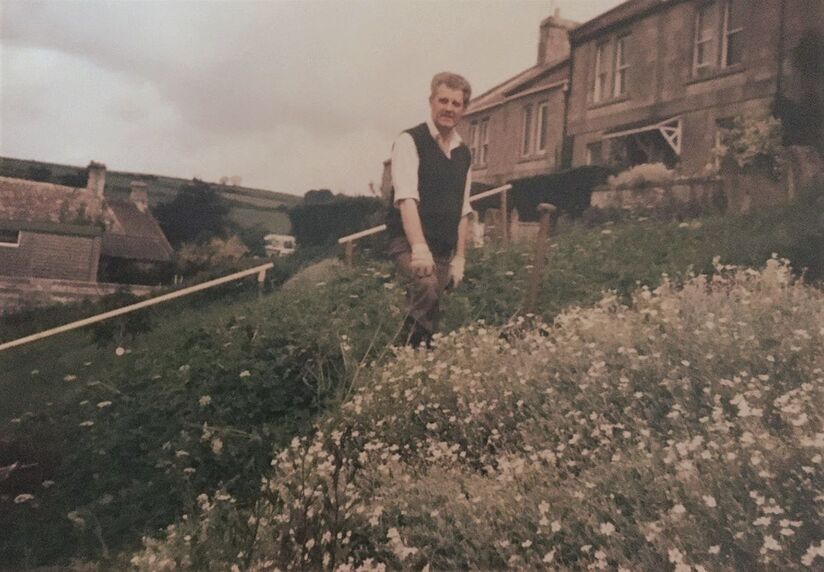Decline of the Bath & Portland Stone Firms Limited
Alan Payne Research Richard & Derek Head and Roger Oliver September 2019
Alan Payne Research Richard & Derek Head and Roger Oliver September 2019
This picture shows railway lines in the foreground and the view over the Rec towards Box School with its clock tower (courtesy Roger Oliver). It's what isn't there that is more significant. There is no Fairmead View because the terraced rank hadn't been built yet. We can date the photo fairly accurately to 1896-1911 because the clock was installed to commemorate Queen Victoria's Diamond Jubilee in 1896 and Fairmead View was built in 1911. The stone trade was booming in the years immediately before the First World War.
The Ups and Downs of the Industry
One of the amazing features of late Victorian Box was how quickly fortunes could be made and how fast they were lost in the inter-war years. The classic example of this is the stone quarry trade in the area. The wealth of the quarry-owners was enormous and, with a highly-trained workforce and abundant building materials, they reshaped the appearance of central Box. Without them the main road might still go through The Market Place and the terraces of cottages along the A4 route might never have been built.
The growth of The Firms (as they were known) wasn’t straight forward or continuous. Rather, it was a series of cyclical periods of growth and contraction. In other words, much like the building trade in modern times or the economic vicissitudes of many primary sector industries involved in extracting natural resources and raw materials.
Local depression in stone industry was reported before the First World War in the Parish Magazine of 1907 and continuing in the winter of 1908:
January 1907 It is to be hoped that with the New Year there may be a revival of trade as many have suffered considerably of late from lack of work and consequent reduction of income.
February 1907 The soup kitchen was opened on 1 January and there does not seem any falling off in the numbers of those who take advantage of this help; soup is given out on Tuesday and Fridays in each week.
November 1908: The rebuilding of the Church wall provided work for several men who have for so long been unemployed. I felt that to give employment to a few men would be better than promiscuous charity to many.
After the war the situation worsened with General Depression:
In 1923 Vicar Sweetapple wrote about the lack of work: May God stir Box to cast off lethargy and carelessness and awake our higher interests.
In January 1924 emigration to Australia was in many young people’s minds. The Parish Magazine reported: We would remind any lads thinking of seeking a career in another land of the splendid opportunities offered by the Australian government to boys between the ages of 15 and 18. A number of quarrymen moved to the coal mines of Wales.
One of the amazing features of late Victorian Box was how quickly fortunes could be made and how fast they were lost in the inter-war years. The classic example of this is the stone quarry trade in the area. The wealth of the quarry-owners was enormous and, with a highly-trained workforce and abundant building materials, they reshaped the appearance of central Box. Without them the main road might still go through The Market Place and the terraces of cottages along the A4 route might never have been built.
The growth of The Firms (as they were known) wasn’t straight forward or continuous. Rather, it was a series of cyclical periods of growth and contraction. In other words, much like the building trade in modern times or the economic vicissitudes of many primary sector industries involved in extracting natural resources and raw materials.
Local depression in stone industry was reported before the First World War in the Parish Magazine of 1907 and continuing in the winter of 1908:
January 1907 It is to be hoped that with the New Year there may be a revival of trade as many have suffered considerably of late from lack of work and consequent reduction of income.
February 1907 The soup kitchen was opened on 1 January and there does not seem any falling off in the numbers of those who take advantage of this help; soup is given out on Tuesday and Fridays in each week.
November 1908: The rebuilding of the Church wall provided work for several men who have for so long been unemployed. I felt that to give employment to a few men would be better than promiscuous charity to many.
After the war the situation worsened with General Depression:
In 1923 Vicar Sweetapple wrote about the lack of work: May God stir Box to cast off lethargy and carelessness and awake our higher interests.
In January 1924 emigration to Australia was in many young people’s minds. The Parish Magazine reported: We would remind any lads thinking of seeking a career in another land of the splendid opportunities offered by the Australian government to boys between the ages of 15 and 18. A number of quarrymen moved to the coal mines of Wales.
Problems and the Decision to Sell, July 1934
The Firms had survived all these downturns in an organised and systematic way. They hunkered down, knowing that Box’s housing stock was in poor shape and needed modernising with indoor running water, lavatories and bathrooms. The likelihood was that householders would sell part of their garden for infill building of new houses and the Firms would be able to take advantage of the opportunity. There were other advantages for the Bath and Portland. They were able to adjust very quickly because much of their workforce was mostly subcontracted and could be laid off almost immediately by not offering a new contract for work.
But the decline in the 1930s was of an entirely different order. Easily-extractable stone seams had dried up and the economic depression in the early years of that decade was unlike an earlier downturn in its severity. At the same time, the cost of maintaining the quarries was catching up on years of neglect and the roots of the depression had been obvious for a number of years. In 1931 a pooling of resources was proposed with two other firms in the Portland workings, as the industry was suffering from the effects of a depression in the masonry trade in London and the provinces.[1] It was a further consolidation of the move away from Wiltshire. The profits of The Firms halved from 1931 £67,875 to 1932 £37,025.[2] The accounts referred to the acute depression mentioned in the last report (which) became intensified … every branch of building and public works construction has been held up owing to Government’s curtailing of public expenditure.[3] The profit for 1933 was a dismal £9,290 almost all of which was paid as a dividend.
The Firms made massive cost reductions and talked a good game to reassure shareholders.[4] But the decision was made to sell surplus assets to survive. These included the terraced cottages in Box notwithstanding that they were only a generation old. The auction of their entire building estate was organised by Charles W Oatley of Box and was held on 10 July 1934 at the Bingham Hall for the Box properties and the following day the properties at Whitley, Neston and Corsham were auctioned. The decision was largely that of Alan N Pictor (1982-1968), who served as managing director from his appointment in 1932 until 1940.
The Firms had survived all these downturns in an organised and systematic way. They hunkered down, knowing that Box’s housing stock was in poor shape and needed modernising with indoor running water, lavatories and bathrooms. The likelihood was that householders would sell part of their garden for infill building of new houses and the Firms would be able to take advantage of the opportunity. There were other advantages for the Bath and Portland. They were able to adjust very quickly because much of their workforce was mostly subcontracted and could be laid off almost immediately by not offering a new contract for work.
But the decline in the 1930s was of an entirely different order. Easily-extractable stone seams had dried up and the economic depression in the early years of that decade was unlike an earlier downturn in its severity. At the same time, the cost of maintaining the quarries was catching up on years of neglect and the roots of the depression had been obvious for a number of years. In 1931 a pooling of resources was proposed with two other firms in the Portland workings, as the industry was suffering from the effects of a depression in the masonry trade in London and the provinces.[1] It was a further consolidation of the move away from Wiltshire. The profits of The Firms halved from 1931 £67,875 to 1932 £37,025.[2] The accounts referred to the acute depression mentioned in the last report (which) became intensified … every branch of building and public works construction has been held up owing to Government’s curtailing of public expenditure.[3] The profit for 1933 was a dismal £9,290 almost all of which was paid as a dividend.
The Firms made massive cost reductions and talked a good game to reassure shareholders.[4] But the decision was made to sell surplus assets to survive. These included the terraced cottages in Box notwithstanding that they were only a generation old. The auction of their entire building estate was organised by Charles W Oatley of Box and was held on 10 July 1934 at the Bingham Hall for the Box properties and the following day the properties at Whitley, Neston and Corsham were auctioned. The decision was largely that of Alan N Pictor (1982-1968), who served as managing director from his appointment in 1932 until 1940.
|
The Sale Particulars
As always true to their support of the workforce, there was a condition in the auction: Each house shall be first offered separately so that the Tenant may have an opportunity of acquiring the house he or she occupies, and then if unsold the blocks of houses will be offered. The Firms even went as far as arranging that liberal advances from local building societies can be obtained if required. In Box thirty-two properties were auctioned, a building plot next to Clift Quarry Works, an acre of land at Box Fields and a plantation of timber on the Bradford Road. The Box properties comprised the ranks of terraces at Bath Road, Fairmead View, Mill Lane and Woodstock. The company could not bear to part with its headquarters at Clift Quarry Works and the quarry there, the buildings, machinery, implements and stock-in-trade were specifically excluded from the sale as was the Roadway and/or Tramway to Clift Works together with the mineral extraction rights. None of the properties was older than thirty years; Fairmead View only 20 years. Many still had their original occupants, some had the widow of the quarryman. |
We are very fortunate in having a record of the auction details which shows the following:
Number |
Tenant |
Annual Rent |
Sale Price |
Bought |
Bath Road |
. |
. |
. |
. |
1 |
C Eyles |
£16.0s.8d |
£305 |
G Bradfield |
2 |
W Sawyer |
£16.0s.8d |
£295 |
Not Sold |
3 |
A Sawyer |
£16.0s.8d |
£290 |
Not Sold |
4 |
Mrs Ford |
£16.0s.8d |
£295 |
Not Sold |
5 |
G Allsop |
£16.0s.8d |
£295 |
Scobell |
6 |
S Giles |
£16.0s.8d |
£295 |
Not Sold |
7 |
Mrs A Smith |
£16.0s.8d |
£295 |
Not Sold |
Number |
Tenant |
Annual Rent |
Sale Price |
Bought |
Fairmead View |
. |
. |
. |
. |
17 |
F Simpkins |
£16.0s.8d |
. |
Not Sold |
18 |
J Tottle |
£16.0s.8d |
. |
Not Sold |
19 |
A L Fido |
£16.0s.8d |
. |
Not Sold |
20 |
A Head |
£16.0s.8d |
. |
Not Sold |
21 |
J Greenman |
£16.0s.8d |
. |
Not Sold |
22 |
Mrs Slade |
£16.0s.8d |
. |
Not Sold |
23 |
A Hughes |
£16.0s.8d |
. |
Not Sold |
24 |
Wilts Constabulary |
£15.18s.0d |
. |
Not Sold |
25 |
||||
26 |
||||
27 |
Number |
Tenant |
Annual Rent |
Sale Price |
Bought |
Mill Lane |
. |
. |
. |
. |
1 |
E Toy |
£14.6s.0d |
. |
|
2 |
HO Stacey |
£14.6s.0d |
. |
Not Sold |
3 |
J Scobell |
£14.6s.0d |
. |
Not Sold |
4 |
W Webster |
£14.6s.0d |
. |
Not Sold |
5 |
E Hancock |
£14.6s.0d |
. |
Not Sold |
6 |
A Guy |
£14.6s.0d |
. |
Not Sold |
7 |
G Moody |
£14.6s.0d |
. |
Not Sold |
8 |
CE Smith |
£14.6s.0d |
. |
Not Sold |
Number |
Tenant |
Annual Rent |
Sales Value |
Bought |
Woodstock |
. |
. |
. |
. |
Cottage 1 |
F Gilham |
Total for |
Total for |
All three |
Cottage 2 |
Mrs Hancock |
All three |
All three |
Bought by |
Cottage 3 |
Mrs Thorn |
£29.13s.8d |
£205 |
Mr Chaffey |
End of The Firms
The Firms were pleased when the military services took over parts of the quarries because they were exempted from maintenance. The company tried to diversify its products in the Second World War with Moon Aircraft production at the Clift Quarry site and the business struggled on in the late 1940s manufacturing a wide range of Perspex and plastic domestic products. With the war many newcomers arrived in Box and they took occupation of some of the Box terraces, which ceased to be predominantly houses for quarrymen. In this respect, the story of these cottages mirrored the history of the whole village. In 1985 the Bath and Portland Stone Firms Limited were sold to Amey Roadstone Construction and underwent various changes until some quarrying rights were taken over by the Hanson Group.
It was a rather sad ending for the business which had dominated Box for the best part of a century. In retrospect we can admire the integrity of Alan Pictor in trying to dispose of the building portfolio in a way which respected the village and the tenants. It preserved their history for us all to enjoy. How wonderful it would have been if we could have preserved the quarry history in a better way. Despite the efforts of a few people (including Aubrey Pinker in the 1960s and David Pollard at the turn of the century) we allowed them to be filled with oil and waste and our experience of them locked away out of sight.
The Firms were pleased when the military services took over parts of the quarries because they were exempted from maintenance. The company tried to diversify its products in the Second World War with Moon Aircraft production at the Clift Quarry site and the business struggled on in the late 1940s manufacturing a wide range of Perspex and plastic domestic products. With the war many newcomers arrived in Box and they took occupation of some of the Box terraces, which ceased to be predominantly houses for quarrymen. In this respect, the story of these cottages mirrored the history of the whole village. In 1985 the Bath and Portland Stone Firms Limited were sold to Amey Roadstone Construction and underwent various changes until some quarrying rights were taken over by the Hanson Group.
It was a rather sad ending for the business which had dominated Box for the best part of a century. In retrospect we can admire the integrity of Alan Pictor in trying to dispose of the building portfolio in a way which respected the village and the tenants. It preserved their history for us all to enjoy. How wonderful it would have been if we could have preserved the quarry history in a better way. Despite the efforts of a few people (including Aubrey Pinker in the 1960s and David Pollard at the turn of the century) we allowed them to be filled with oil and waste and our experience of them locked away out of sight.
References
[1] Bath Weekly Chronicle and Herald, 23 December 1933
[2] Western Mail and South Wales News, 20 March 1933
[3] Bath Weekly Chronicle and Herald, 24 March 1934
[4] Bath Weekly Chronicle and Herald, 31 March 1934
[1] Bath Weekly Chronicle and Herald, 23 December 1933
[2] Western Mail and South Wales News, 20 March 1933
[3] Bath Weekly Chronicle and Herald, 24 March 1934
[4] Bath Weekly Chronicle and Herald, 31 March 1934
